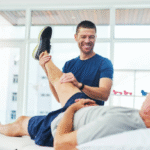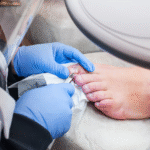
Physical Therapy Treatments for Stroke Patients: A Complete Guide
September 26, 2025
Podiatry Solutions for Bunions and Ingrown Toenails
September 26, 2025
Knee injuries are among the most common musculoskeletal issues, affecting people of all ages. Whether caused by sports, accidents, or age-related wear and tear, knee injuries can significantly limit your mobility and daily activities. Physical therapy is often the cornerstone of recovery, helping to restore strength, flexibility, and function while preventing future injuries. In this article, we’ll explore effective physical therapy exercises for knee injury recovery, explaining each exercise in simple terms and giving practical guidance to help you get back on your feet safely.
Understanding Knee Injuries
The knee is a complex joint made up of bones, ligaments, tendons, and cartilage. Common knee injuries include:
- Anterior Cruciate Ligament (ACL) tears: Usually caused by sudden stops or changes in direction.
- Meniscus tears: Often from twisting motions or heavy lifting.
- Patellar tendinitis: Inflammation of the tendon connecting the kneecap to the shinbone.
- Knee bursitis: Inflammation of the small fluid-filled sacs around the knee.
Recovery depends on the type and severity of the injury. Physical therapy exercises are designed to strengthen surrounding muscles, improve joint mobility, and reduce pain.
Benefits of Physical Therapy for Knee Injuries
Engaging in physical therapy exercises offers multiple benefits:
- Strengthening muscles: Strong quadriceps, hamstrings, and calves support the knee and reduce stress on the joint.
- Restoring flexibility: Gentle stretching helps maintain the knee’s range of motion.
- Improving balance and stability: Exercises target the muscles around the knee and hip to prevent falls.
- Reducing pain and inflammation: Gradual strengthening and controlled movement reduce stiffness and discomfort.
- Preventing future injuries: Proper exercise techniques train the knee to handle daily and sports-related activities safely.
Key Physical Therapy Exercises for Knee Injury Recovery
1. Quadriceps Sets
Purpose: Strengthens the quadriceps (front thigh muscles) to support the knee.
How to do it:
- Sit or lie down with your leg straight.
- Tighten the thigh muscles by pressing the back of your knee toward the floor.
- Hold for 5–10 seconds.
- Relax and repeat 10–15 times per leg.
Tips: Avoid locking the knee. Start gently and increase intensity gradually.
2. Straight Leg Raises
Purpose: Strengthens quadriceps without putting pressure on the knee.
How to do it:
- Lie on your back with one leg bent and the other straight.
- Tighten your thigh muscles of the straight leg.
- Lift it slowly to the height of your bent knee.
- Hold for a few seconds and lower it slowly.
- Repeat 10–15 times for each leg.
Tips: Keep your back flat and avoid jerky movements.
3. Hamstring Curls
Purpose: Strengthens the back thigh muscles (hamstrings) to stabilize the knee.
How to do it:
- Stand behind a chair or hold onto a counter for support.
- Bend one knee, bringing your heel toward your buttocks.
- Hold for 5 seconds and slowly lower.
- Repeat 10–15 times per leg.
Tips: Start with body weight before using ankle weights for added resistance.
4. Heel Slides
Purpose: Improves knee flexibility and range of motion.
How to do it:
- Lie on your back with both legs straight.
- Slowly slide one heel toward your buttocks, bending the knee.
- Hold for 5 seconds, then slide the leg back.
- Repeat 10–15 times per leg.
Tips: Move slowly to avoid pain, especially in early recovery stages.
5. Step-Ups
Purpose: Enhances strength and balance, mimicking daily activities like climbing stairs.
How to do it:
- Stand in front of a step or low platform.
- Step up with your injured leg first, then bring the other leg up.
- Step down slowly and repeat 10 times per leg.
Tips: Start with a low step and increase height gradually. Support yourself with a railing if needed.
6. Wall Slides
Purpose: Strengthens quadriceps and stabilizes the knee joint.
How to do it:
- Stand with your back against a wall and feet shoulder-width apart.
- Slowly slide down as if sitting on an invisible chair, keeping knees behind toes.
- Hold for 5–10 seconds and slide back up.
- Repeat 10–12 times.
Tips: Avoid deep squats that cause pain or strain.
7. Calf Raises
Purpose: Strengthens calves to support the knee and improve balance.
How to do it:
- Stand with feet hip-width apart near a wall or chair.
- Raise your heels off the ground and stand on your toes.
- Hold for 3–5 seconds, then lower slowly.
- Repeat 15 times.
Tips: Keep movements slow and controlled to maximize benefit.
Guidelines for Safe Knee Recovery
- Warm-up first: Gentle movements or a short walk increases blood flow and prepares muscles.
- Listen to your body: Mild discomfort is normal, but stop if you experience sharp pain or swelling.
- Progress gradually: Increase intensity, repetitions, or resistance slowly.
- Combine with flexibility exercises: Stretching helps maintain a healthy range of motion.
- Consult a physical therapist: Personalized programs ensure exercises match your specific injury and recovery stage.
Recovery Timeline
- First 1–2 weeks: Focus on gentle range-of-motion exercises and reducing swelling.
- Weeks 2–6: Introduce strengthening exercises like quadriceps sets, straight leg raises, and hamstring curls.
- Weeks 6–12: Gradually add weight-bearing and balance exercises like step-ups and wall slides.
- After 12 weeks: Continue strengthening, balance, and flexibility exercises to prevent future injuries.
Recovery varies depending on injury type, age, and overall health. Patience and consistency are key.
FAQs about Physical Therapy Exercises for Knee Injury Recovery
1. Can I start exercises immediately after a knee injury?
It depends on the injury. Minor injuries may allow gentle range-of-motion exercises immediately, but severe injuries or surgery often require initial rest. Always follow your doctor or physical therapist’s advice.
2. How often should I do these exercises?
Most exercises can be done 3–5 times per week. Your therapist may adjust frequency based on your recovery progress.
3. Will these exercises completely heal my knee?
Exercises help strengthen and stabilize the knee, improve mobility, and reduce pain. However, some injuries may require surgery or additional medical interventions for full recovery.
4. Can I do these exercises at home?
Yes. Most exercises are simple and safe for home use. Make sure to follow proper form and progress gradually.
5. How long does it take to see improvement?
Improvement can be noticed within 4–6 weeks with consistent exercise, though full recovery may take several months depending on the injury’s severity.
Conclusion
Physical therapy exercises play a vital role in knee injury recovery, helping restore strength, flexibility, and function. By practicing exercises like quadriceps sets, straight leg raises, hamstring curls, and wall slides, you can regain mobility safely and reduce the risk of future injuries. Remember, consistency, patience, and professional guidance are key components of effective recovery. Incorporating these exercises into your routine will not only help heal your knee but also improve your overall stability and confidence in daily activities.

